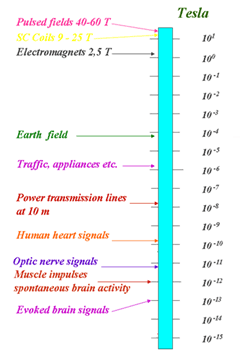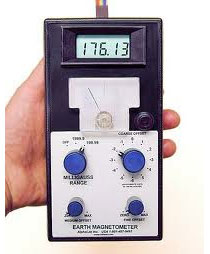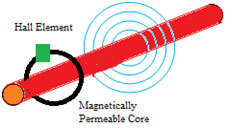We are all probably aware of the fact that magnets create magnetic fields; the earth has a magnetic field; current flowing in a wire also generates magnetic field. But have we realized that fields are also generated by our heart and brain? However, what differs between the magnetic field generated by a magnet and that generated by the brain and heart is the magnitude of the magnetic field. The following figure shows the magnitude of magnetic fields generated by various sources.
Fig. 1: A figure explaining the magnitude of magnetic fields generated by various sources
We are all surrounded by magnetic fields. Magnetic fields are generated by the flow of electrical current in various electrical/electronic devices; TV, computers, power transmission lines, etc. The Earth also has its own magnetic field, albeit a relatively small one. Earth's magnetic field is greatest at the poles (~60,000 nT) and lowest at the equator (~30,000 nT). The intensity of the Earth's magnetic field is proportional to 1/r3 (until the influence of the solar wind becomes noticeable).
Fig. 2: A figure demonstrating the ratio of the Earth's magnetic field intensity to 1/r3r
The measurement of magnetic fields is of interest for various scientific purposes, navigation, etc. These fields are measured by sensing devices called magnetometers.
MAGNETOMETER – WHAT IS IT?
Figure 3: A representative image of a magnetometer
Magnetometers are devices that measure magnetic fields. A magnetometer is an instrument with a sensor that measures the magnetic flux density B (in units of Tesla or As/m2). Magnetometers refer to sensors used to detect magnetic fields OR to systems that measure magnetic fields using one or more sensors.
Since the magnetic flux density in air is directly proportional to the strength of the magnetic field, a magnetometer is capable of detecting fluctuations in the Earth's field.
Materials that distort magnetic flux lines are known as magnetics and include materials such as magnetite, which have magnetic fields of their own as well as very high magnetic conductivity. These materials create distortions in the Earth's magnetic flux flowing around it. Magnetometers detect these distortions.
A magnetometer measures the magnetic flux density at the point in space where the sensor is located. A magnetic field decreases in intensity as the cube of the distance from the object. Therefore, the maximum distance that a given magnetometer can detect the object is directly proportional to the cube root of the magnetometer's sensitivity. Sensitivity is commonly measured in Tesla.
Types of magnetometers
Magnetometers are classified into two categories:
• Vector magnetometers that measure the value of flux density in a specific direction in three-dimensional space. An example is a fluxgate magnetometer that can measure the strength of any component of the Earth's field by orienting the sensor in the direction of the desired component.
• Scalar magnetometers that measure only the magnitude of the vector that passes through the sensor, regardless of the direction. Quantum magnetometers are an example of this type of magnetometer.
Various magnetometers used to measure magnetic fields are discussed in the following sections.
Coil magnetometer
Based on Faraday's law, the coil is the fundamental method of detecting the magnetic field. Faraday's law states that the emf induced in any closed conducting coil is equal to the rate of change of magnetic flux through the circuit.
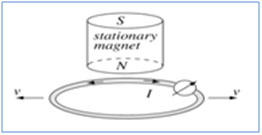
Fig. 4: A diagram demonstrating a coil magnetometer
With a coil having N turns wound around a magnetic material with magnetic permeability L R & and a flux f through it, the emf induced in the coil is:

Fig. 5: An equation showing the relationship between emf, flux density, coil area, and angle between the two
If the magnetic field has harmonic variation with time, the induced voltage is proportional to the frequency of the magnetic field.
Thus, the induced emf depends on the area of the coil. The sensitivity of the small coil magnetometer depends on the size and number of turns. This is used to detect only variations in the field (due to motion or the AC nature of the field). Since normally B needs to be measured instead of dB/dt, an integrator is normally used to obtain a signal proportional to the magnetic field B.
This is useful in areas such as mine detection or buried object detection (pipe detection, “treasure” hunting, etc.). It is often used because of its simplicity.
Hall Sensors
Hall Sensors
The principle of the Hall Effect states that when a current-carrying conductor is placed in a magnetic field, a voltage will be generated perpendicular to the direction of the field and the flow of current.
When a constant current passes through a thin sheet of semiconductor material, there is no potential difference across the output contacts if the magnetic field is zero. However, when a perpendicular magnetic field is present, the current flow is distorted. The uneven distribution of electron density creates a potential difference between the output terminals. This voltage is called Hall voltage. If the input current is kept constant, the Hall voltage will be directly proportional to the magnetic field strength. The Hall effect sensor depends on polarity. If the current changes direction or the magnetic field changes direction, the polarity of the Hall voltage changes.
Fig. 6: A diagram representing Hall sensors
Hall voltage is a low-level signal of the order of 20 – 30 volts in a one gauss magnetic field and requires amplification. The Hall voltage is linear with respect to the field for certain currents and dimensions. The Hall coefficient is temperature dependent and must be compensated if accurate detection is required.
Fig. 7: A diagram explaining the Hall coefficient as temperature dependent
Magnetoresistive sensors
Magnetoresistive sensors
Magnetoresistive sensors are based on two principles.
The first principle involves those that have a basic structure similar to Hall elements, but with n Hall voltage electrodes. Electrons are affected by the magnetic field as in the hall element because of the magnetic force on them; they will flow in an arc.
Fig. 8: A figure illustrating magentostrictive sensors
The greater the magnetic field, the greater the radius of the arc. This forces the electrons to take a longer path. Resistance to its flow increases. A relationship between magnetic field and current is established and therefore the resistance of the device becomes a measure of field. The relationship between field and current is proportional to B 2 for most configurations. It depends on the mobility of the carrier in the material used (usually a semiconductor). The exact relationship is quite complicated and depends on the device geometry.
Another principle used by magnetoresistive sensors is the property of some materials to change their resistance in the presence of a magnetic field (caused by the Lorentz force). Most conductors have positive magnetoresistivity; its resistance increases in the presence of a magnetic field.
AMR (anisotropic magnetoresistance) are metals with highly anisotropic properties and change their magnetization direction due to field application.
Magnetostrictive Sensors
Magnetostrictive Sensors
Magnetostriction involves two effects: the contraction or expansion of a material under the influence of the magnetic field (Joule effect) and the inverse effect of changes in the material's susceptibility when subjected to mechanical stress (Villari effect). This bidirectional effect between the magnetic and mechanical states of a magnetostrictive material is a transduction capability used for both actuation and sensing. The magnetostrictive effect is quite small and requires indirect methods to measure it.
The operation is explained in the following figure. The change in length is proportional to the magnetic field.
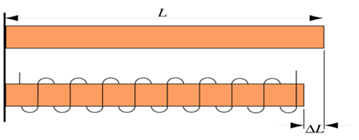
Fig. 9: A diagram explaining the operation of magentostrictive sensors
Fluxgate magnetometer
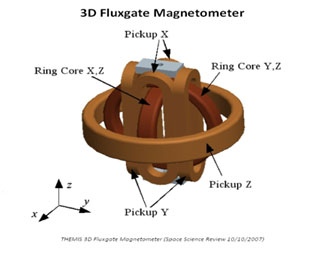
Fig. 10: A figure demonstrating the Fluxgate magnetometer
Originally designed to detect submarines in World War II, Fluxgate magnetometers detect the strength and orientation of magnetic fields. They are used to measure fluctuations in Earth's magnetic field due to solar winds and shifts in plate tectonics. Many space applications have used fluxgate magnetometers to detect the planet's and moon's gravitational fields and their orientation.
Fluxgate sensors are much more sensitive than coil magnetometers, although a little more complex. Can be used as a general purpose magnetic sensor. It is used in electronic compasses, detection of fields produced by the human heart, fields in space.
The underlying principle of the magnetometer is explained below:
An external magnetic field H applied to a ferromagnetic core induces a magnetic flux in the core; B = ?H (? is the permeability of the material). For high values of H the material saturates and the magnetic flux B cannot be increased further.
When the core is not saturated, nearby flux lines are drawn into the core. When the core is saturated, the magnetic flux lines are no longer affected by the core
Fig. 10: A diagram explaining the magnetic field strength in saturated and unsaturated nuclei
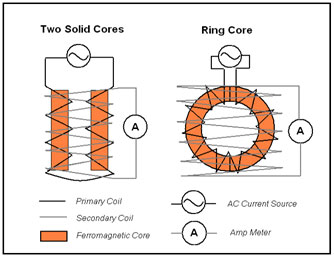
Fig. 11: A figure explaining two solid nuclei and a ring nucleus
Two coils are wound on highly ferromagnetic cores, a conductive coil and a sensing coil. The conducting coil drives the core in and out of saturation by applying an excitation current through the coil. Whenever magnetic flux lines are drawn from the core, they induce a positive current spike in the sense coil. When they are pulled into the nucleus, they generate a negative current in the sensing coil (Lenz's law). The signal induced in the sensing coil is proportional to dB/dt.
The two nuclei are placed close to each other, symmetrically opposite. Each core is wound on a primary coil; the primary windings are inverted from each other. An alternating current is applied to the primary windings producing a variable magnetic field in both cores.
When no external magnetic field is present, the magnetic fields induced in the nuclei are equal and opposite, canceling each other out. When an external magnetic field is present, the nucleus that generates a field opposite to its direction will come out of saturation sooner, while the nucleus aligned with its direction will come out of saturation later. During this time the fields do not cancel each other out and there is a net change in flow. This change in flux induces a voltage in the secondary windings that can be measured
The magnetization curve for most ferromagnetic materials is highly nonlinear. Almost any ferromagnetic material is suitable as a core for fluxgate sensors. In practice, the coil is driven by an AC source (sinusoidal or square). Under no external field, the magnetization is identical along the magnetic path. Hence, the search coil will produce zero output.
If there is an external magnetic field perpendicular to the sensing coil, this condition changes and, in effect, the core becomes non-uniformly magnetized. It produces an emf in the detection coil of the order of a few mV/ l T. The reason for the name fluxgate is the change of flux in the core in opposite directions.
Magnetostrictive materials are highly nonlinear. The sensors thus produced are extremely sensitive – with sensitivities from 10 – 6 to 10 – 9 It is quite common.
Fluxgate sensors can be designed with two or three axes. Fluxgate sensors are available in integrated circuits where Permalloy is the material of choice as it can be deposited into thin films and its saturation field is low. However, current integrated fluxgate sensors have lower sensitivities – on the order of 100 l T – but still higher than other magnetic field sensors.
Chinese YH-1 Mars Exploration Satellite Used Fluxgate Magnetometers for Space Magnetic Field Measurements
Proton magnetometer
Proton magnetometer
Also known as proton precession magnetometers, PPMs, they measure the resonance frequency of protons or hydrogen nuclei in the magnetic field to be measured. Since the precession frequency depends only on the atomic constants and the strength of the ambient magnetic field, the accuracy of this type of magnetometer can reach 1 ppm .
A polarized DC current is passed through a coil wound around a liquid sample (water, kerosene or similar), thus creating an auxiliary magnetic field and also causing the protons to polarize for stronger liquid magnetization. When the auxiliary flow ends, the “polarized” protons precess to realign them to the normal flux density. The precession frequency is directly proportional to the magnetic flux density.
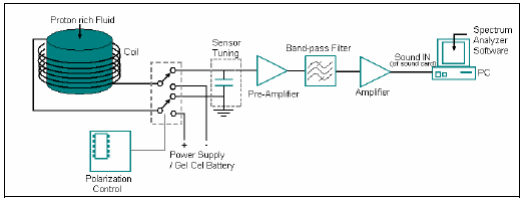
Fig. 12: A figure explaining the process flow of the proton magnetometer
Proton precession measurements are necessarily sequential. This means there is an initial bias, followed by a frequency measurement – after which the cycle repeats. This differs from continuous measurements where the cores are polarized and frequency measurements are made simultaneously.
Overhauser magnetometers
Overhauser magnetometers
High sensitivity; superior omnidirectional sensors; no dead zones; no course errors; or heating time; wide operating temperature range; robust and reliable design; low maintenance; high absolute precision, fast operating speed; Exceptionally low power consumption are some of the features of Overhauser magnetometers.
In Overhauser magnetometers, a special liquid (containing free, unpaired electrons) is combined with hydrogen atoms and then exposed to the secondary polarization of a radiofrequency (RF) magnetic field.
Due to exposure to RF energy, the free electrons in the special liquid transfer their excited state (i.e. energy) to the hydrogen nuclei (i.e. protons). This energy transfer changes the spin state populations of the protons and polarizes the liquid – just like a proton precession magnetometer – but with much less power and to a much greater extent.
RF magnetic fields are ideal for use in magnetic devices because they are “transparent” to the Earth’s “DC” magnetic field and the RF frequency is well outside the bandwidth of the precession signal (i.e., they do not contribute to noise for the measurement system).
The proportionality of precession frequency and magnetic flux density is perfectly linear, independent of temperature, and only slightly affected by the shielding effects of hydrogen's orbital electrons.
Compared to proton precession magnetometers, Overhauser magnetometers
1. It has a lot of sensitivity, matching cesium magnetometers.
two. Offers continuous or sequential operation.
3. They have a higher sampling rate.
Optical pumped magnetometers
Optical pumped magnetometers
The optically pumped magnetometers include 1 nuclear magnetometer (Helium 3) and four electron resonance magnetometers (Helium 4, Rubidium, Cesium and Potassium).
Alkaline vapor optically pumped magnetometers use gaseous alkaline metals from the first column of the periodic table, such as Cesium, Potassium, or Rubidium.
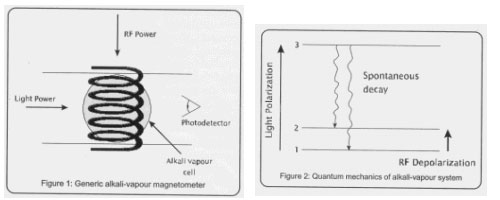
Fig. 13: A diagram of a glass vapor cell containing gaseous metal is exposed to light of very specific wavelength
A glass vapor cell containing gaseous metal is exposed to light of very specific wavelength. The frequency of light is specifically selected and circularly polarized for each element to shift electrons from ground level 2 to excited state 3. Electrons in level 3 are not stable, and these electrons spontaneously decay to both energy levels 1 and 2 Eventually, level 1 is completely filled. When this happens, the absorption of polarized light stops and the vapor cell becomes more transparent.
Then, RF depolarization comes into play. RF power corresponding to the energy difference between levels 1 and 2 is applied to the cell to move electrons from level 1 back to level 2 (and the cell becomes opaque again). The frequency of the RF field required to repopulate level 2 varies with the ambient magnetic field and is called the Larmor frequency. Depolarization by a circular magnetic field at the Larmor frequency will rebalance the populations of the two Earth levels and the vapor cell will begin to absorb more polarized light.
The effect of polarization and depolarization is that the intensity of light is modulated by the RF frequency. By detecting the modulation of light and measuring the frequency, we can find a value of the magnetic field.
LULA
LULA
SQUID stands for S superconductor QU antum L interference D device. They are the most sensitive of all magnetometers, they can detect up to 10 – 1 5 T. They operate at very low temperatures – usually at 4.2 ° K (liquid helium). There are also higher temperature SQUIDs and integrated SQUIDs. Still, SQUIDs are not as common as other types of sensors; they cannot simply be taken off the shelf and used.
SQUIDs are based on the so-called Josephson junction; a junction formed if two superconductors are separated by a small insulating gap (discovered in 1962 by BD Josephson). If the insulator between two superconductors is thin enough, superconducting electrons can tunnel through the insulator. The base material is usually niobium or a lead (90%)-gold (10%) alloy.
There are two basic types of SQUIDs. RF (radio frequency) SQUIDs that have only one Josephson junction and DC SQUIDs that usually have two junctions. DC SQUIDs are more expensive to produce, but are much more sensitive.
The main difficulty with SQUIDs is the cooling requirement and the required mass. However, it is an extremely valuable sensor where the cost can be justified. It is used exclusively in applications such as magnetoencephalography. Measurements of very low magnetic fields are made in shielded rooms where the Earth's magnetic field can be eliminated.
Forms
MAGNETOMETER APPLICATIONS:
1. They are used for navigation purposes.
two. They are used in anti-lock braking systems in vehicles.
3. Fluxgate magnetometers have been used on space missions for magnetic field measurements.
4. Magnetometers are used for mineral exploration; is used to search for deposits of gold, silver, iron, copper, etc.
5. They are used in many defense applications; UAVs, submarines, etc.
6. Magnetometers have found use in smartphones that have apps that function as compasses.
7. And many more..
References
GMW, Magnetometers: a comprehensive guide
